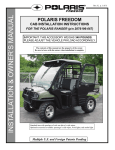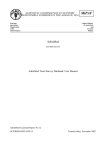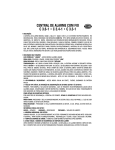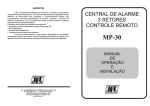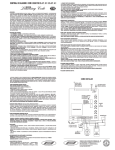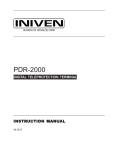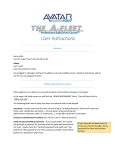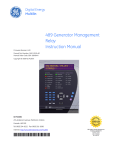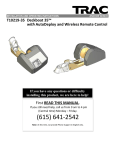Download Medium Duty Hybrid Electric Medium Duty Hybrid Electric
Transcript
Medium Duty Hybrid Electric PACRI P.O. Box 1518 Bellevue, WA 98009 Y53-6031 Operator’s Manual Supplement Medium Duty Hybrid Electric System Supplemental This supplement contains information that is not included in your current Operator's Manual. This supplement is in addition to the information contained in Eaton’s Hybrid Transmission Driver Instructions manual and applies to all vehicles equipped with the Eaton diesel/electric hybrid powertrain. (12/09) Y53-6031 –1– IMPORTANT SAFETY INFORMATION MEDIUM DUTY HYBRID ELECTRIC SYSTEM SUPPLEMENTAL Important Safety Information Most accidents that involve the operation, maintenance or repair of a vehicle or its components are caused by the failure of a person to observe and follow basic safety rules. Accidents can often be avoided by a person identifying and avoiding potentially hazardous situations. This requires a person to constantly pay attention, be alert and deliberate. The safety signals (Warning, Caution and Note) in this manual and on the vehicle are not inclusive. It is the responsibility of the operator to constantly be alert for ANY condition which represents a potential safety hazard. “WARNING”, “CAUTION”, or “NOTE”. Please do not ignore any of these alerts. WARNING When you see this word, the message that follows is especially vital. It signals a potentially hazardous situation which, if not avoided, could result in personal injury or death. This message will tell you what the hazard is, what can happen if you don't heed the warning, and how to avoid it. Example: WARNING! Never carry additional fuel containers in the vehicle. Such containers, full or empty, may leak, explode or cause a fire in the event of a collision. Failure to comply may result in personal injury, death, equipment or property damage. Safety Signals Alerting messages are in this manual. Please read and follow them. They are included for your protection and information. These messages can help you avoid injury to yourself and others. In some cases, the information will help prevent costly damage to your vehicle. CAUTION Key symbols and “signal words” are used to indicate what kind of message is going to follow. Pay special attention to instructions prefaced by symbols and signal words –2– Y53-6031 Signals a potentially hazardous situation which, if not avoided, could result in property or vehicle damage. (12/09) MEDIUM DUTY HYBRID ELECTRIC SYSTEM SUPPLEMENTAL SAFETY SIGNALS Example: CAUTION: Continuing to operate your vehicle with insufficient oil pressure will cause serious engine damage. Immediately shut off your engine and determine the cause of the problem. Failure to do so may result in equipment or property damage. Please take the time to read these messages when you see them, and remember: WARNING! Something that could injure you or could cause death. CAUTION: NOTE Provides general information: for example, the note could warn you on how drive the vehicle more efficiently. Something that could cause property or vehicle damage. NOTE: Useful information. Example: NOTE: Pumping the accelerator will not assist in starting the engine. (12/09) Y53-6031 –3– SYSTEM DESCRIPTION HYBRID ELECTRIC SYSTEM Hybrid Electric System System Description NOTE: Information provided in this supplemental operator’s manual is intended to compliment the Eaton Driver Instruction Manual. Any conflicting details provided in Eaton’s Driver Instruction manual supersede information in this manual. The hybrid system in this vehicle incorporates an electric motor/generator that supplements the diesel engine to improve fuel economy. Depending on the vehicle’s intended service, this system may be comprised of (1) a Hybrid Drive Unit, (2) a Power Electronics Carrier (PEC), (3) a power inverter, (4) an optional DC/DC converter and (5) a dedicated hybrid coolant fill tank. All of these components work in conjunction to supplement power from the diesel engine. 4 (behind batteries) 3 (under step cover) 5 1 2 WARNING! Do not use the PEC as a step. Use only the steps and handholds provided. Using the PEC as a step may result in personal injury and/or equipment damage. –4– Y53-6031 (12/09) HYBRID ELECTRIC SYSTEM OPERATION Operation Operating a hybrid vehicle is not much different than operating a conventional diesel engine while starting vehicle. In most cases, the hybrid electric motor will crank the engine. Operators may notice a slight delay between turning the key and the engine cranking. The vehicle also has a 12V starter to start the vehicle in situations where the hybrid system is not able to provide power to the vehicle. Once the engine is started and idling, it will remain idling until the load demands more torque (via accelerator pedal) than what the electric motor is able to provide. In some situations, the batteries may not be sufficiently charged to provide the necessary torque. In these situations, the engine speed will increase to provide torque. Batteries may also be charged while coasting, slowing down and full braking (in Drive or Reverse). This process is called regenerative braking. An operator will detect regenerative braking because the vehicle will coast as if the vehicle is moving up a grade. The system will disengage regenerative braking once the batteries are at full charge. (12/09) WARNING! Be prepared to apply service brakes with the foot pedal when the system disengages the regenerative braking. Failure to do so may result in a loss of vehicle control which could lead to an accident involving death or personal injury. There may be times when regenerative braking does not provide enough energy to charge the batteries. In these situations, the hybrid system computer will optimize the use of diesel engine energy to charge the batteries. A vehicle that is idling, except when in ePTO mode (see next paragraph), will not charge the hybrid system batteries. NOTE: The hybrid system battery performance may be affected by outside temperature and extensive (greater than 6 months) storage without charging. Refer to “340 Volt PEC Batteries” on page 13 for maintenance instructions to follow if the vehicle will not be used for extended periods longer than 6 months. Depending on the vehicle’s configuration, the hybrid system may have an ePTO mode. In this mode, the operator will be able to operate equipment without using the engine. When ePTO mode is engaged, the engine will Y53-6031 –5– OPERATOR INTERFACE HYBRID ELECTRIC SYSTEM automatically turn on and off to charge the hybrid system batteries. Operator Interface Transmission Controls* NOTE: The ePTO mode will only engage when the hood is in the closed position and the park brake is applied. Refer to the Eaton Driver Instruction Manual for more details regarding ePTO operation. HYBRID SYSTEM MONITOR Some vehicles may be equipped with a PTO that is driven by the engine only. These PTO’s are separate from the hybrid system and the engine will run continuously regardless of battery state of charge. ELEC MOTOR ePTO MPG CHECK HYBRID STOP HYBRID DATA FAILURE Hybrid Display Dash Panel * This is a generic respresenation. The actual transmission control panel may be different than shown. The operator has access to system information through a dedicated screen display located on the dash. After the vehicle progresses through the Power On Self Test (POST), the display will provide the user with the following real time information: • • • • –6– Y53-6031 Hybrid system mode Dynamic fuel economy Battery charge status Warnings and Alerts (12/09) HYBRID ELECTRIC SYSTEM OPERATOR INTERFACE spin for added visual effects. The display will dynamically change to reflect the current mode of the hybrid system. HYBRID SYSTEM MONITOR Dynamic Fuel Economy ELEC MOTOR ePTO The right side of the display has a vertical graduated scale to represent fuel economy. The meter will show to be ‘full’ when maximum fuel economy is met. MPG Hybrid System Mode MPG The hybrid system has 5 different modes: Battery Charge Status 1. Engine 2. Hybrid power (combined engine-battery propulsion) The graphic for the battery contains bars that indicate the level of charge available for use. 3. Electric launch (battery only propulsion) 4. ePTO (when equipped with the feature.) 5. Hybrid charge (recharge the main batteries) Each mode will appear across the top of the display and the image will be animated indicating the direction and source of energy. In addition, the specific component will light up or become faded and the wheels will (12/09) Y53-6031 At full charge, all bars will be green and the image will glow in a green light. The number of bars illuminated will reduce as the batteries discharge. As the batteries continue to discharge; the image will glow in an amber color and the bars will change to amber. –7– OPERATOR INTERFACE HYBRID ELECTRIC SYSTEM NOTE: During normal operation, the battery charge status image may display no charge. If there is a system problem, the display will provide sufficient warning as described in the following section. Warning Lights and Alerts The bottom of the display is reserved for warning icons. These icons will light up and then fade out when the vehicle is first turned on, during the Power On Self Test (POST) cycle. Any icons remaining on after 4 seconds indicate an issue with the hybrid system. The display will flash the warning icon and then will remain solid. The STOP HYBRID icon will also be accompanied with an audible signal. CHECK HYBRID –8– STOP HYBRID CHECK HYBRID:The hybrid system has detected a system malfunction when this icon remains on steady or is blinking. Stop the vehicle when it is safe to do so. Consult the Troubleshooting section of the Eaton Driver instruction and Hybrid transmission service manual. STOP HYBRID: Stop the vehicle when it is safe to do so, set the parking brakes, and have the vehicle towed or trailered to an authorized dealership for repairs. Consult the Vehicle Recovery (towing) section of the vehicle Operator's Manual for proper towing instructions. DATA FAILURE: The hybrid system display is receiving corrupt information or no information at all. Stop the vehicle when it is safe to do so, set the parking brakes, and have the vehicle towed or trailered to an authorized dealership for repairs. Consult the Vehicle Recovery (towing) section of the vehicle Operator's Manual for proper towing instructions. DATA FAILURE Y53-6031 (12/09) HYBRID ELECTRIC SYSTEM DRIVERS CHECKLIST Drivers Checklist In addition to the drivers checklist found in your operator’s manual, the operator should check the following: 1. Check the hybrid coolant level. Top off as necessary with extended life coolant. Refer to the instructions “Hybrid Vehicle’s Cooling System” on page 12 for information regarding adding coolant to the proper level. 2. Visually inspect all orange high voltage cables of the hybrid system for signs of rubbing, chafing or other signs that the cable insulation has been compromised. WARNING! Examine the cables for signs of damage or chafing. A chafed or damaged cable, in which wiring is exposed, can arc against metal components and cause a fire which can lead to death, personal injury or damage to equipment. The hybrid system utilizes regenerative braking to charge the hybrid batteries. Regenerative braking engages as soon as the operator removes his or her foot from the accelerator pedal. Allow the vehicle to coast as often as possible so the system will keep the batteries at a higher state of charge. The hybrid system is most effective during gradual acceleration from a full stop. Rapid acceleration will engage the diesel engine and will result in more fuel consumption. In ePTO mode, the hybrid system will turn the engine on and off as needed to maintain battery state of charge and to maximize fuel economy. Overriding the hybrid system to force the engine to idle will not maximize fuel economy. Allowing the hybrid system to determine when the engine should be on or off will maximize fuel economy. Tips to maximize fuel economy This hybrid system relies on the hybrid batteries located in the Power Electronics Carrier (PEC) to power the vehicle (or ePTO components) in lieu of the diesel engine. (12/09) Y53-6031 –9– PREVENTIVE MAINTENANCE SCHEDULE HYBRID ELECTRIC SYSTEM Preventive Maintenance Schedule Your preventive maintenance program begins with the daily checks you perform. If you check your vehicle regularly, you may avoid many large, expensive, and time-consuming repairs. Your vehicle should operate better, be safer, and last longer. Neglect of recommended maintenance can void your vehicle’s warranty. Some maintenance operations demand skills and equipment you may not have. For such situations, please take your vehicle to an authorized Service Center. PREVENTIVE MAINTENANCE (PM) INTERVALS I A B C D E At the first 15,000 mi./ 24,000 km or at the first PM 15,000 mi./ 24,000 km/ Monthly 30,000 mi./48,000 km 60,000 mi./ 96,000 km/6 months 120,000 mi./ 192,000 km/Annually 240,000 mi./ 384,000 km NOTES: •Maintenance requirements of specific vocational configurations will dictate whether the intervals used are determined based on mileage, time in service, hours operating, etc. WARNING! It can be dangerous to attempt maintenance work without sufficient training and the proper tools. You could be injured, or you could make your vehicle unsafe. Do only those maintenance items you are fully trained and equipped to do. Failure to comply may result in personal injury, death, equipment or property damage. •These maintenance practices and intervals are intended as additional requirements and are not to replace, in whole or in part, the pretrip inspection requirements of the Commercial Driver’s License (CDL) as established in the Federal Commercial Motor Vehicle Safety Act of 1986. •Before attempting any procedures in the engine compartment, stop the engine and let it cool down. Hot components can burn skin on contact. •Be alert and cautious around the engine at all times while the engine is running. – 10 – The charts on the next page show the maintenance intervals for recommended maintenance practices. Y53-6031 (12/09) HYBRID ELECTRIC SYSTEM SYSTEM COMPONENT PREVENTIVE MAINTENANCE SCHEDULE Recommended PM Interval MAINTENANCE TASK I Cooling Hybrid System Flush, drain, and refill with new coolant (see “Hybrid Vehicle’s Cooling System” on page 12) Power Electronics Carrier Air filter Inspect and replace when necessary (see “Air Filter” on page 12) 340 V Battery Inspect and maintain charge (see “Power Electronics Carrier (PEC)” on page 12) High voltage (Orange) Cables Inspect and replace when necessary (Dealer serviceable item) Hybrid System (12/09) Y53-6031 A B C D E X X X X – 11 – HYBRID VEHICLE’S COOLING SYSTEM HYBRID ELECTRIC SYSTEM Hybrid Vehicle’s Cooling System 3. Remove the four 10 mm capscrews that hold the PEC air filter cover to the PEC. This hybrid vehicle has an independent cooling system to help keep the motor/generator, the inverter and the DC/ DC converter (in certain applications) at a specific operating temperature. The coolant fill cap and tank are located in the engine compartment (mounted to the firewall as shown in figure on page 4). It is not the same tank that holds coolant for the engine. Ensure that the coolant fill tank has fluid in the tank up to the line on the tank indicating the proper fluid level. Refer to the Eaton’s Hybrid Transmission Driver Instructions manual (TRDR1000) for extended life coolant specifications. 4x 4. The air filter will pull out once the cover is removed. NOTE: the PEC air filter is directional and must be installed correctly to provide proper function. 5. Install a new filter so that the short side of the filter faces out. To drain the system, find the lowest point in the cooling system. The lowest point should be the hose connection to the hybrid drive unit. Power Electronics Carrier (PEC) Short side Air Filter 1. Set the vehicle’s parking brake. 2. Turn the vehicle’s ignition to the ‘OFF’ position. – 12 – Y53-6031 (12/09) HYBRID ELECTRIC SYSTEM FRAME MODIFICATIONS 6. Reinstall the cover with the 4 capscrews and tighten them to 14-20 ft - lbs (19-27 Nm). Air filter servicing instructions may also be found in Eaton’s Hybrid transmission service manual. 340 Volt PEC Batteries The 340V PEC state of charge needs to be maintained. If you turn the ignition switch to the accessory position and the battery state of charge is showing less than fully charged, then the batteries need charging. (See section below for procedure.) During extended periods of storage, the PEC batteries will slowly discharge. Please follow these additional steps if you plan on storing the hybrid vehicle for an extended period of time to help prolong their useful life: How to charge the hybrid batteries • Start the vehicle. • Drive the vehicle and allow the hybrid system to either use regenerative braking or the diesel engine to charge the hybrid batteries. • If the vehicle is equipped with an ePTO, the operator may select ePTO mode on the transmission selector panel. The hybrid system will shut the engine off once the batteries are sufficiently charged. Please contact your authorized dealership if the batteries become fully discharged. Frame Modifications • Every 6 months turn the ignition to the accessory position and check the battery state of charge. Charge the batteries if they are not fully charged, see section below for procedure. • Do not store the batteries where they will be subjected to extreme cold or heat. (12/09) Y53-6031 WARNING! Do not cut, splice or weld frame rails. Do not drill through the top or bottom flanges of the frame rail. These operations could affect frame rail strength leading to a failure which may result in death or serious personal injury. Always leave frame modifications to your authorized dealer. – 13 – Medium Duty Hybrid Electric PACRI P.O. Box 1518 Bellevue, WA 98009 Y53-6031 Operator’s Manual Supplement















